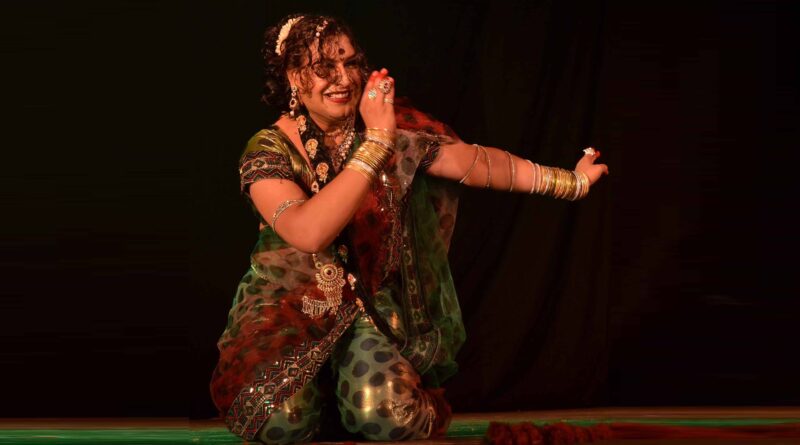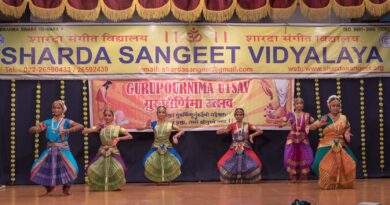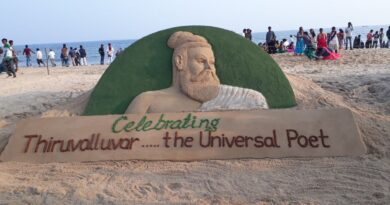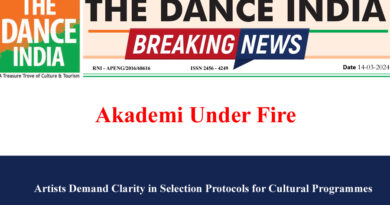Folk Dances of Maharashtra
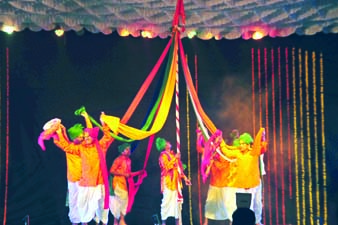
The term ‘Folk Dance’ is self-explanatory. Performed by folk or ‘any group of people’ and it is an inseparable part of our Folk Culture. Folk Culture relates with the ethos of specific communities. Though its origin has evolved from a primitive culture, it encompasses the modern culture also thus revealing its in-depth magnitude. ‘Folk Dance’ relates to our rich traditional heritage and hence imparts a much-esteemed contemporary significance too.
According to A J Agarkar, ‘Folk Dance’ could be described appropriately as follows – “Amongst the primitive people of all times, ceremonial dancing has been considered a matter of great importance and used frequently as a means of sympathetic magic. If our contemporary ancestor wants to kill a bear, he goes through all the performances of hunting as a ritualistic dance and ends up by wearing some part of the animal skin.” ‘Folk Dance’ relates to our spontaneous expressions with stylised additional energy. This ‘additional energy’ is expressed creatively through various dance-postures. This is commonly seen in humans as well as animals. Folk Dances that are thousands of years old have been traced by way of ancient paintings and ancient stone-carvings – these again depict various dance forms and point to our rich cultural heritage!
In these dancing pictures, we see the pictures of primitive people and of animals. Primitive people nurtured festive traditions, which are clearly seen in their various dance forms.
When our forefathers would go for hunting, they followed a specific ritual. They would clothe themselves with animal-skins before resorting to specific ritual dance forms.
Dance is an essential component seen at every stage of life viz. birth, adolescence, youth (which encompasses sexual attraction), marriage – and different events like hunting, war-times and even in the death rituals.
The different forms of Dances could be segregated as follows – as a dance of people; ‘traditional dance’, ‘improvised’ dance, ‘dance of selflessness’, ‘choreographed’ dance by a particular community. In India, there are several castes and tribes which are engaged in performing ‘Folk Dance’ purely as a Profession. These dance forms are not identified as ‘Classical Dance Forms’ but essentially as forms of the ‘Folk Dance’.
Folk dance has always been identified as a vernacular dance form. The book, Folklore and Folklife: An Introduction edited by Richard M Dorson, has a specific concept about vernacular dance. ‘1’
Dorson states, “A vernacular dance form performed in either its first or second existence as a part of the little tradition within the great tradition of given society.”
“It is understood that the dance is an effective mode of expression which requires both time and space. It employs motor behaviour in redundant patterns which are closely linked to the definitive features of musicality.”
Folk Dance always co-relates with the ‘Cosmic Theory’ of the Universe, as the original patterns of the folk dances are circular or semi-circular in nature. These traditional patterns of folk dances are illustrations of monotony (not only of the dance forms but also of the monotony of nature and the Cosmic World as well).
The classification of Folk Dances is done taking into consideration different aspects like –‘Rasas’ (Expressions), geographical diversities, various religious cults with diversified motives and the places of performance are also considered. There exists a clear-cut demarcation of folk dances such as ‘ritualistic’ Folk Dances, ‘devotional’ Folk Dances, Folk Dances with ‘social messages’, Folk Dances belonging to a particular community, ‘gender-specific’ Folk Dances and there are yet ‘purely entertaining’ Folk Dances too!
Maharashtra proudly owns a rich heritage of ancient culture and tradition of Folk Dances that are stunning and vibrant in nature. We commonly find all the above-mentioned categories of dance forms in Maharashtra.
Ritualistic Dance Forms
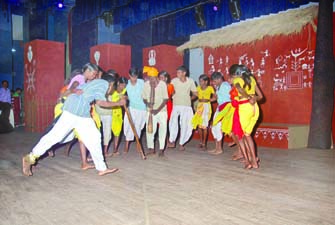
Talking about Ritualistic Folk Dances, dancing remains an integral part of many ritualistic folk plays. It is certainly one in kind with the primitive notion that dancing is an essential part of the ritual; with the only variation that it seldom approaches the fixed and definite method and happens to be more of a ‘disciplined form’ that denotes the characteristic of a ‘ritual’ dance. We find ‘ritualistic’ dance forms in ‘Khandoba Jagran’ of Waghya Murli, together with Amba, Bhavani, Renuka, Gondhal of ‘Gondhali’ – of common prevalence in Maharashtra.
‘Waghya Murli’ performs the ritualistic ‘folk play’ with Jagran while Gondhalis perform another type of ‘folk play’ called Gondhal. During performing these ‘ritualistic folk plays’ the participants not only worship Lord Khandoba and Goddess Renukadevi but also dance while performing the ‘folk plays’. As it is defined as a lesser form of a disciplined form, it is also defined as a natural style of dancing. Therefore, while Murlis dance during the ‘Jagran’ presentation, they dance expressing intense devotion towards Khandoba. There are specific steps along with body-movements; as they sing and perform together, their movements are limited in nature. Having Ghati (a cymbal like an instrument) in one hand they dance using only one hand. If the dance has to be classically defined, then it could be said that it has ‘Hansasya Hastamudra’ and ‘Ek Paad Chakkar’ while their ‘bent-back’ posture is shown to be similar to that of a Lotus Bark (‘Kamal Kalika’) which is incorporated in classical dance form. The hand-movements of ‘Murali’ while dancing, resembles an elephant picking the sugarcane in its trunk. These hand movements of Murali are known as ‘Gajgras’ seen in a Classical Dance form.
While all these movements are performed, there is no science involved in it but only a natural style of dancing prevails which enables them to dance as well as sing. Similarly, in Gondhal, the Gondhali (male performer) dances voluntarily on the beats of Sambal and at the same time, sings ‘Gondhal’ songs which are devotional in nature. These are sung while worshipping Goddess Renukabai. In this performance, the little ‘jumps’, ‘chakkars’ (circular movements) that the Gondhali performs are spontaneous and not pre-planned; it is entirely natural and free from any specific boundaries.
Devotional Dance Forms
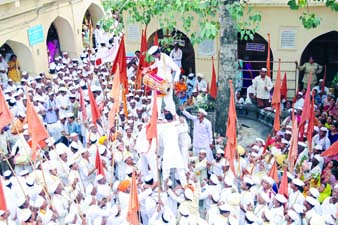
While talking about Devotional Folk Dances, they are natural like we find the spontaneous devotional dance forms in ‘Bharud’ and ‘Kirtan’ which we also get to observe in the ‘Warkari Kirtan’ or ‘Dindi Dance’ which is performed during the 15 days of pilgrimage. Bharud is another form of devotional performance wherein we see dancing in its natural form. The ‘Bharudkar’ or the ‘Performer’ while preaching and giving a spiritual message dances on the rhythm of Pakhawaj and Cymbal. Bhardukar sings the opening line, preaches and in between dances to its glory swaying his hands and adding spontaneous little jumps on the beats. Thus it involves three things – singing, preaching and dancing. This kind of dancing is rendered as ‘devotional dancing’.
The ‘Bhagawat Sampradaya’ popularly known as ‘Varkari Cult’ follows its own unique devotional dance called Dindi-Palkhi dance. The dance is not a choreographed one but is extempore and spontaneous with an overflow of devotional expressions of the Varkari (Pilgrims) – the ardent devotees of God Vithal. The Varkaris/Pilgrims dance with unbounded enthusiasm all the way to Pandharpur to see Lord Vithoba during ‘Ashadhi Ekadashi’ and also walk down to Alandi of Saint-Dnyaneshwar during ‘Kartiki Ekadashi’. The participants generally fall in two rows facing one another. The Mridanga and the Vina players who lead the dance walk between the rows. The rhythm-strings are interlocked which keeps them compact and in position. The other devotional ‘Folk Dance’ forms like Fugdi, Zimma, Pinga, Atyapatya, Logori, Chendufali are seen in the ‘Dindi-Palkhi’ Festival. The Pilgrims sing the narratives of the Saints and the ‘dance forms’ are based on the same.
Bohada
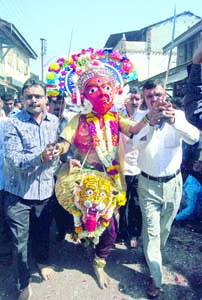
Bohada which is also known as Panchami, Akhadi, Chaitee constitutes a ‘dance drama’. It is popular in the tribal belt of Thane district, Palghar district, Nashik and Nagar district. Akhadi, Panchami and Chaitee all these three forms are inter-related to mythological stories. The stories of the Ramayana, the Mahabharata, Lalit and Dashawatara also resemble the ‘Bohada’. The word ‘Folk-ballet’ could be coined for Bohada and ‘Bohada-like’ forms. These are performed in the Annual Village Festival colloquially known as ‘Grandmotsava’. Divine characters like Ganapati, Riddhi, Siddhi, Saraswati enter first (with the necessary masks) at the holy place of Bohada and then characters like Ram, Laxman, Rawan, Hanuman, Tratika, Bhasmasur, Bhairavnath, Khandoba appear on the scene in the open holy place of the villages. The characters perform the elite warrior-dance. Goddess Amba makes her appearance and the villagers seek Her blessings and offer Her with oblations of Coconut and flowers. Ganapati enters with a ‘holy dance steps’ which is a mythological convention since He is known as the ‘God of Performing Art’. The performance reaches a crescendo with the musical instruments like Dhol, Sanai, Manjiri, Sambal being played simultaneously in Bohada.
Dance Forms Conveying Social Messages
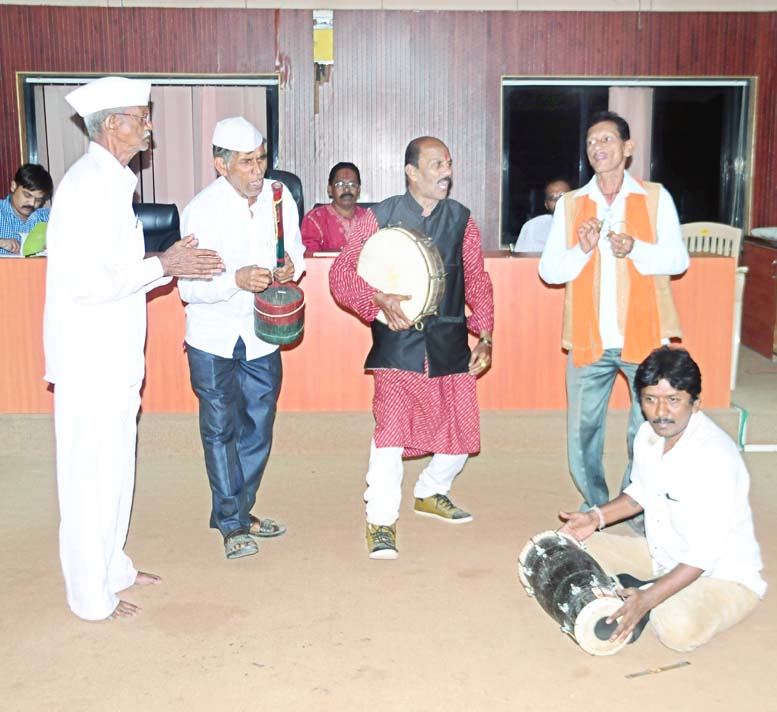
There are various Dance-forms which do the noble job of conveying ‘Social Messages’. Amongst them, ‘Powadas’ (Ballads) have been popular ever since the time of Shivaji Maharaj. Powada has an inbuilt ‘Veer Ras’ (Spirit of Valiance) in it and successfully narrates the tales of Chhatrapati Shivaji Maharaj and other brave warriors. It is well known for the priceless propagation of social doctrines and pronouncing social messages at various levels. Powadas were extensively used during the Freedom Movement of India and when Maharashtra was separated. A Powada essentially consists of the ‘Shahir’ (or the ‘Bard’) who enacts the stories entwined into ‘dance forms’. Though it may not be a complete form of ‘dance’, it has a subtle form of ‘dance’ with ‘drama expressions’ wherein the artist enacts different characters through facial expressions and body language. Powada (known as a ‘Ballad’ is a part of ‘Oral Poetry’ which goes hand-in-hand with performances related to the poetry mingled with dance, enactment and singing. Folk dances are particularly performed along with ‘Oral Poetry’ and are traditional products of Verbal Poetic Narrations that are transmitted from generation to generation. The same is the case with folk dances which are traditional as well as contemporary in nature. This Tradition is a combination of speech, music and dance. The steps of Ballad singing often vary from each other. The steps in ‘Powada Gayan’ (Ballad-Singing) are unique and definite and it is precisely the narration of a spectacular victory of a particular dynasty or a brave warrior.
Ballads fall under two classifications – ‘total oral’ poetry and ‘partially oral; partially written’ poetry. Ballads were initially composed in a mythological form but later on, as different developments and progressive changes started having a profound influence over the mankind, they eventually developed into complex varied forms like the historical, revolutionary, contemporary, conveying social messages etc. Agindas and Tulsidas were two renowned ballad singers who sang traditional ‘Gondhalis’ and had composed ballads in Chatrapati Shivaji Maharaj regime during the seventeenth century. We often witness ballad singers who use the ‘Daf’ (‘Tambourine’) and assume the characteristic posture wherein the person places his right leg in front and the left leg at the rear; moreover, they often keep jumping on their feet while they vividly narrate the victorious moments of the hero. They create an environment of valour and enact the victorious moments by artistic singing and dancing. In Maharashtra we have well-acclaimed Traditional Ballad Singers like Sidram Basappa Muchate, Shankarrao Nikam, Pirajirao Sarnaik, Shahir Lahari Haidar, Shahir Pandurang Khadilkar, Shahir Naniwadekar, Shahir Krishnarao Sable, Shahir Atmaram Patil, Shahir Amarsheikh, Shahir Annabhau Sathe, Shahir Gavankar, Shahir Vitthal Umap, Shahir Liladhar Hegde, Shahir Dada Kondke, Shahir Bapurao Vibhute, Shahir Babasaheb Deshmukh. Their performances constitute a powerful blending of ballad singing and various folk dances and are highly appreciated by people at large!
Entertaining Dance Forms
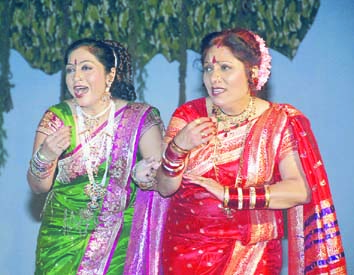
‘Lavani’ is identified with the word “Lawanya” which means ‘Aesthetic Beauty’ and is the type of dance performed in the folk theatre while Tamasha is rich in ‘Sringar Ras’ (Romanticism) both – drawing a large appreciative crowd. Clad in beautiful nine-yard saris, the main dancer, (along with her troupe of women), present Lavani with their sensuous and gracefully moves. With Ghungroos (anklet-bells) chiming around their dancing feet, they dance gracefully with beautiful facial- expressions!
Lavani went through a social stigma as it was performed in Royal Courts of the Peshwas but later it regained its honour. There are two types of Folklores – Tamasha, ‘Dholki Fadacha Tamasha’ (Deewan-e-Aam) and ‘Sangeet Baricha Tamasha’ (Deewane-e-Khas). Lavani is performed in both these forms.
Since Lavani has a rich legacy of dancers, it is known to be the ‘Queen of Folk Art’. The term Lavani is derived from the word ‘Lavanya’ which means ‘beauty’. Lavani was in full bloom in the later phase of the Peshwa period in the early nineteenth century. Two Schools of Thought emerged concerning the etymology of Lavani – one School believes that Lavani had its roots in the devotional narratives of the saints. The Second School believes that Lavani is purely an outcome of ‘erotic poetry’ and inherited by the traditional nomadic communities of Maharashtra. When the Muslim Emperors invaded South India they roped in the ‘Mujra’ culture of the North to South India. It is one of the most popular folk dance forms of Maharashtra and is an aesthetical combination of singing, enactment and dance.
The aforesaid Muslim Emperors and soldiers tried to entertain themselves not with ‘Mujra’ but developed fancy for ‘Lavani’. Taus, Tambori, Dhol were the initial folk instruments used rampantly in ‘Lavani’. Dholki, Harmonium and Tabla became active components of ‘Lavani’ at a later stage. The characteristic feature of ‘Lavani’ was ‘Singing’ and ‘Enactment’ (also called ‘Adakari’) – these came to be introduced first and the dance component was introduced later. There are Lavanis’ which are characteristically ‘devotional’ and ‘ballad-type’. In such types, social atmosphere and people with their beliefs are depicted along with sex-education for the ladies, marriage-related customs. In this process of imparting educational touch, various shades of feminine beauty, dresses, ornaments together with the different hues of emotions of women and men are also depicted in Lavani. The excellence of the Lavani singers and Lavani dancers has taken this Folk Art not only on the National platform but also on the International platform too. Yamunabai Waikar, a traditional Lavani artiste is the recipient of Padma Shri Award whereas Vithabai Narayangaonkar, Satyabhamabai Pandharpurkar, Yamunabai Waikar are recipients of Sangeet Natak Academy Awards from the Government of India. It is a proven fact that Lavani artistes like Madhu Kambikar, Chhaya-Maya Khutegaonkar, Rajashri Nagaokar, Reshma-Varsha Paritekar, Pramila Lodgekar, Maya Jadhav, Vaishali Parbhanikar have performed Lavani exceptionally well on an International platform in Dubai, China, Russia, France and U.S.A. respectively. Sulochana Chavan and Roshan Satarkar, two Lavani singers made it so popular that Lavani reached from the courtyard to the kitchen winning the hearts of the women-folk. The well-known Music Critic and Artist Dr Ashok Ranade conceived the unique concept called ‘Baithakichi Lavani’ and moulded it into a creative and artistic Programme that was originally based on the classical Lavani singing of later Peshwa period. The name of Dnyanoba Utpat of Pandharpur is well known amongst those who composed the ‘Lavani Programme’. The efforts of these two had taken Lavani to a level of elite calibre. The Government of Maharashtra organises the Lavani Festival annually in their honour.
Assorted Folk Dance Forms
Balya Dance Jakhadi
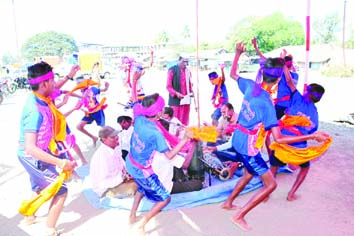
In Raigadh and Ratnagiri districts of Maharashtra, Naman Khele and Jakhadi are the prominent ‘Folk Forms’. Naman Khele is purely ‘Dramatic Folk Forms’ which is performed in the ‘Holi Season’ whereas Jakhadi (also known as ‘Balya Dance’) is performed during Ganesh Festival. The word ‘Balya Dance’ is attributed to artistes wearing earrings called ‘bali’ while they were performing. Due to ‘bali’, the ‘Balya’ dance term has evolved. Another reason why this term is used owes to the participation of the children in the dance performance. The artistes are amateurs and wear earrings and don ‘ghungru’ (‘anklet-bells) on their left leg. Dholaki, Tal and Ghunguru (bound to a stick) are the instruments used in Jakhadi. Jakhadi dance is performed in a ‘circular form’. The instrument players are at the centre of the circle and other participants dance perform from outside the circle. This dance is vibrant and the main artist who is designated as ‘Chief’ or ‘Buwa’ sings the divine songs of Ganapati, Riddhi, Siddhi, Saraswati. ‘Gan, Gaulan’ are assorted mythological narratives. Some mythological ‘riddle-songs’ are presented in Jakhadi along with the same pattern of dance throughout. In Naman Khele Ganesh, Riddhi, Siddhi, Saraswati and other mythological characters participate in the arena of Naman Khele. This can be designated as a ‘Pure Folk Theatre’. Kalyachi fugdi, Tichki dance, Chapai dance, Radha dance, Gauri dance, Dhol dance, Tarpa dance, Takla dance – these various dance forms are very popular in Konkan belt which also includes Thane, Palghar and Tribal districts. In Sawantwadi Tehsil, Sindhudurga district, everybody popularly knows Chapai dance of the ‘shepherd community’. It resembles the ‘Gaja Dance’ of Western Maharashtra. Musical instruments like Dhol, Khaital (Big Zanz) Sanai are the instruments used in ‘Chapai’ and in ‘Gaja’ dances respectively. These dances are performed to mark respect to the ‘home-deities’ of the Shepherds which are – Biroba and Jotiba. Participants from different dance-patterns; to illustrate, they endeavour high jumps in circular movement holding a handkerchief in one hand. They also prepare and play in a circle with ‘Gof.’ (They place cotton threads alongside a wooden pillar and play with these threads.) ‘Gof’ dance is also extensively performed in Junnar Tehsil of Pune district as the performers are from the Tribal Thakar Community. They use instruments like Dhol, Tasha and Zanz while dancing. Lezim is also widely popular in Maharashtra and has various patterns.
Koli Dance
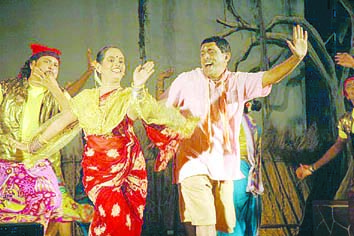
Koli dance is very popular among the Fishermen Community. Goddess Ekvira and God Khandoba are known as their family-deities. Dhol), Pipani, Sanai and Ghumat are the instruments used in Koli dance. Koli dance is performed during Festive times like the ‘Coconut day’, Ganesh Chaturthi, Holi and even in the marriage rituals of fishermen community. They invoke and praise God Khandoba and Goddess Ekvira in the songs when men and women dance together. There are specific occasions for dancing such as Padva; Akshaya Tritiya; Ashadhi Ekadashi; Month of Shravan; Narali Purnima; Ganesh Chaturthee; Navaratri, Holi etc.
In Vidarbha, ‘Khadi-Gammat’ ‘folk play’ happens to be a ‘Special Gavlan Dance’ performed only by men. Kham and Dandar are the folk dance forms in Vidarbha. Other popular dances are Ghusadi dance, Tipri dance, Ghorpad dance, Holi dance, Banjara dance – these are popular in different tribal communities in Maharashtra. In womenfolk, the Mangalagaur and folk plays during Nagpanchami are also popular. These ‘Folk plays’ and ‘Mangalagaur’ are performed in front of their individual homes and are accompanied by the relatives and family friends.
Colourful folk-dances form the striking identity of Maharashtra’s folk culture, which is diverse in nature, homogenous in soul and strengthens the silken bonds between the people bringing the community close to each other.
Bibliography
1 Folklore and Folklife: An Introduction edited by Richard M Dorson, page 387)
Article authored By Prof. Dr Prakash Khandge
Co-author Sukhada Khandge Khaire

